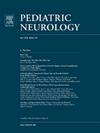Seizures May Worsen Outcomes of Neonatal Hypoxic-Ischemic Encephalopathy: A Longitudinal Serum Biomarkers Study
IF 3.2
3区 医学
Q2 CLINICAL NEUROLOGY
引用次数: 0
Abstract
Background
Understanding if neonatal seizures (Sz) worsen brain injury and outcomes would optimize treatment decisions. We hypothesized that serum central nervous system–specific biomarkers would discriminate neonates with Sz and relate to outcomes.
Methods
This is a retrospective cohort study (April 2009 to November 2019), including neonates in three groups: (1) only Sz without HIE (Sz-no HIE), (2) HIE with Sz (Sz-HIE), and (3) HIE without Sz (no Sz-HIE). Levels of glial fibrillary acidic protein (GFAP, astrocytic reactivity), Tau (neuronal injury), and neurofilament light chain (NF-L, axonal degeneration) were studied at admission/<6 h, <72 h, and 72-144 h of life against time to achieve full oral feeds and NICHD-NRN MRI score.
Results
In 145 neonates included (61% male; 33% black), admission GFAP levels were higher in Sz-HIE than in no Sz-HIE. During the first 72 hours of life, GFAP, Tau, and NF-L levels were similar between Sz-no HIE and Sz-HIE but higher than in no Sz-HIE. After 72 hours, NF-L and Tau remained higher in both Sz groups (versus no Sz-HIE). In adjusted regression models, higher Tau and NF-L percentiles related to longer time to reach full oral feeding and higher odds of more than minimal brain injury in MRI in Sz-HIE.
Conclusions
Tau and NF-L levels are higher in those neonates developing Sz. Although relationships with worse brain injury may be driven by the HIE severity itself, modeling shows Sz as the most important feature, providing support to the notion that Sz may worsen brain injury in neonates with HIE even after TH.
癫痫发作可能加重新生儿缺氧缺血性脑病的预后:一项纵向血清生物标志物研究
背景:了解新生儿癫痫发作(Sz)是否会加重脑损伤和预后,将优化治疗决策。我们假设血清中枢神经系统特异性生物标志物可以区分Sz新生儿并与预后相关。方法采用回顾性队列研究(2009年4月~ 2019年11月),将新生儿分为3组:(1)仅Sz无HIE (Sz-no HIE)、(2)HIE伴Sz (Sz-HIE)和(3)HIE不伴Sz (no Sz-HIE)。在入院后的6小时、72小时和72-144小时,分别研究了胶质原纤维酸性蛋白(GFAP,星形细胞反应性)、Tau(神经元损伤)和神经丝轻链(NF-L,轴突变性)的水平,以及达到完全口服喂养和NICHD-NRN MRI评分的时间。结果145例新生儿(男61%;33%黑人),Sz-HIE患者的入院GFAP水平高于非Sz-HIE患者。在生命的最初72小时内,sz -非HIE和Sz-HIE之间的GFAP、Tau和NF-L水平相似,但高于非Sz-HIE。72小时后,两个Sz组的NF-L和Tau仍然较高(与无Sz- hie组相比)。在调整后的回归模型中,较高的Tau和NF-L百分位数与Sz-HIE患者达到完全口服喂养的时间较长以及MRI中出现轻度以上脑损伤的几率较高相关。结论Sz患儿的stau和NF-L水平较高。虽然与更严重脑损伤的关系可能是由HIE严重程度本身驱动的,但模型显示Sz是最重要的特征,这支持了Sz甚至在TH后也可能加重HIE新生儿脑损伤的观点。
本文章由计算机程序翻译,如有差异,请以英文原文为准。
求助全文
约1分钟内获得全文
求助全文
来源期刊

Pediatric neurology
医学-临床神经学
CiteScore
4.80
自引率
2.60%
发文量
176
审稿时长
78 days
期刊介绍:
Pediatric Neurology publishes timely peer-reviewed clinical and research articles covering all aspects of the developing nervous system.
Pediatric Neurology features up-to-the-minute publication of the latest advances in the diagnosis, management, and treatment of pediatric neurologic disorders. The journal''s editor, E. Steve Roach, in conjunction with the team of Associate Editors, heads an internationally recognized editorial board, ensuring the most authoritative and extensive coverage of the field. Among the topics covered are: epilepsy, mitochondrial diseases, congenital malformations, chromosomopathies, peripheral neuropathies, perinatal and childhood stroke, cerebral palsy, as well as other diseases affecting the developing nervous system.
 求助内容:
求助内容: 应助结果提醒方式:
应助结果提醒方式:


